Videos by Matteo Cristofaro
This development paper, presented at the Western Academy of Management Conference 2021 (virtual),... more This development paper, presented at the Western Academy of Management Conference 2021 (virtual), aims to empirically investigate how cognitive biases influence employees’ product creativity (EPC) and related product performance. In particular, the paper primarily studies: i) the direct effect of employees’ implicit creativity – based on five cognitive biases – and explicit creativity on EPC; and ii) the mediating role of co-workers’ heuristic transfer between shared leadership and EPC. 29 views
Teaching Documents by Matteo Cristofaro
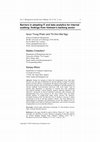
Despite the intention to follow the technological wave, data show that there are still signs of d... more Despite the intention to follow the technological wave, data show that there are still signs of difficulties for internal auditors to adopt IT and data analytics for their activity. Consequently, the purpose of this paper is to answer the research question: what are the barriers in adopting IT and data analytics for internal auditing? Semi-structured interviews with seven banks' head of internal audit department or equivalent in Vietnam have been conducted and analysed through a mixed thematic analysis approach (deductive and inductive). Among the six barriers identified, awareness, data extraction, and implementation have been assessed as the most critical across all banks. Internal auditors of middle-sized banks mostly perceive the obstacles, principally because of the fact that they have to decide to scale up or reduce investments to fit the IT and data analytics solution. This work enhances the understanding by academics and practitioners on how the adoption of IT in internal audits can be fostered, with great implications, and in terms of benefits if organisations can overcome these barriers.
This set of slides, in Italian, helps to study the phenomenon of competitiveness among firms.
That is a PPT presentation used for a lesson about the Business Model Innovation.
The class was ... more That is a PPT presentation used for a lesson about the Business Model Innovation.
The class was held in December 2014 as a part of the larger course "General Management" at the University of Rome Tor Vergata.
Main contents are: business modeling, business model innovation, blue ocean strategy, BMI as a set od key decision.
This presentation (in italian language) is about the recomended decision process that is suggeste... more This presentation (in italian language) is about the recomended decision process that is suggested to make in order to choice the suitable countries in which concentrate the company effort for reaching the internazionalization; particularly, this class is focused on the second driver of the decision process: accessibility of foreign markets.
Questa presentazione riguarda il processo decisionale consigliato per la scelta dei paesi in cui concentrare gli sforzi dell'azienda, al fine di raggiungere l'internazionalizzazione del proprio business; in particolare, questa lezione è focalizzata sul secondo fattore del processo decisionale: l'ccessibilità dei mercati esteri.
This presentation (in italian language) is about the recomended decision process that is suggeste... more This presentation (in italian language) is about the recomended decision process that is suggested to make in order to choice the suitable countries in which concentrate the company effort for reaching the internazionalization; particularly, this class is focused on the first driver of the decision process: attractivity of foreign markets.
Questa presentazione riguarda il processo decisionale consigliato che si propone di fare per la scelta dei paesi in cui concentrare gli sforzi dell'azienda per raggiungere l'internazionalizzazione; in particolare, questa lezione è focalizzata sul primo fattore del processo decisionale: attrattività dei mercati esteri.
Papers by Matteo Cristofaro
International Journal of Organizational Analysis, 2023
Background The decision-making process of organizational agents has been investigated by manageme... more Background The decision-making process of organizational agents has been investigated by management and organizational scholars due to its central role in influencing the operations and performance of organizations. In particular, since the emergence of the disrupting concept of bounded rationality (Simon, 1947)that questioned the previously dominating assumption of perfect rationalityscholarly interest has moved toward understanding the deviations of the human mind from logical and rational choice paths (Cristofaro, 2017). Prolific have been works investigating the role of intuition (
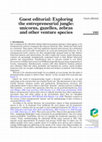
Journal of Small Business and Enterprise Development, 2023
This contribution proposes pioneering the exploration of new entrepreneurial species as a novel a... more This contribution proposes pioneering the exploration of new entrepreneurial species as a novel and essential research avenue within the entrepreneurship domain. The study ventures into unexplored territories of entrepreneurial taxonomy by likening entrepreneurial ventures to diverse species inhabiting a jungle, also thanks to articles published in the related Special Issue. It advocates delving into distinct classifications, such as unicorns, zebras, and gazelles, offering a fresh perspective on their impact on economies and societies. This contribution argues for the relevance of these unique ventures, emphasizing their significant influence on entrepreneurial thought and challenging traditional theories. By shedding light on uncharted species and their inter-relationships, this work opens promising avenues for future research, contributing to the evolving landscape of entrepreneurship studies.
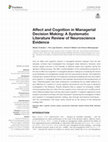
Frontiers in Psychology, Mar 9, 2022
How do affect and cognition interact in managerial decision making? Over the last decades, schola... more How do affect and cognition interact in managerial decision making? Over the last decades, scholars have investigated how managers make decisions. However, what remains largely unknown is the interplay of affective states and cognition during the decision-making process. We offer a systematization of the contributions produced on the role of affect and cognition in managerial decision making by considering the recent cross-fertilization of management studies with the neuroscience domain. We implement a Systematic Literature Review of 23 selected contributions dealing with the role of affect and cognition in managerial decisions that adopted neuroscience techniques/points of view. Collected papers have been analyzed by considering the so-called reflexive (X-) and reflective (C-) systems in social cognitive neuroscience and the type of decisions investigated in the literature. Results obtained help to support an emerging "unified" mind processing theory for which the two systems of our mind are not in conflict and for which affective states have a driving role toward cognition. A research agenda for future studies is provided to scholars who are interested in advancing the investigation of affect and cognition in managerial decision making, also through neuroscience techniqueswith the consideration that these works should be at the service of the behavioral strategy field.

Management Research Review
Purpose How can joint open innovation (OI) projects between small and medium-sized enterprises (S... more Purpose How can joint open innovation (OI) projects between small and medium-sized enterprises (SMEs) and large companies (LCs) be effectively managed? This study aims to try to answer this research question with a focus on the critical success factors (CSFs) of such cooperation. Design/methodology/approach Based on 40 semi-structured interviews with Italian SMEs and LCs engaged in various industries, 20 open OI projects involving SMEs and LCs are investigated using a reflexive thematic analysis, a methodology involving both deductive and inductive approaches. Findings Fifteen CSFs grouped into seven categories emerge from the analysis of joint OI projects between SMEs and LCs. Among them, shared leadership, dynamic decision-making and priority setting emerge as essential elements at the basis of the proposed SMEs–LCs cooperation in joint OI projects that were not sufficiently addressed by prior studies. Originality/value To the best of the authors’ knowledge, this study is the firs...

Management Research Review, 2022
How can joint open innovation (OI) projects between small and medium-sized enterprises (SMEs) and... more How can joint open innovation (OI) projects between small and medium-sized enterprises (SMEs) and large companies (LCs) be effectively managed? This study aims to try to answer this research question with a focus on the critical success factors (CSFs) of such cooperation.
Based on 40 semi-structured interviews with Italian SMEs and LCs engaged in various industries, 20 open OI projects involving SMEs and LCs are investigated using a reflexive thematic analysis, a methodology involving both deductive and inductive approaches.
Fifteen CSFs grouped into seven categories emerge from the analysis of joint OI projects between SMEs and LCs. Among them, shared leadership, dynamic decision-making and priority setting emerge as essential elements at the basis of the proposed SMEs–LCs cooperation in joint OI projects that were not sufficiently addressed by prior studies.
To the best of the authors’ knowledge, this study is the first to provide an evidence-based framework for managing joint OI projects between SMEs and LCs. Relatedly, this study links the practices and most recurring CSFs that facilitate such cooperation.

Technology Analysis & Strategic Management , 2022
How do environmentally-driven and firm-specific factors influence business innovation and adaptat... more How do environmentally-driven and firm-specific factors influence business innovation and adaptation? How can the analysis of their co-evolutionary relationship help explain firm survival or failure over time? To address these key questions, this article focuses on the study regarding the 20-year performance (1997–2017) of the Fiat (later Fiat Chrysler Automobiles) group in the automobile industry. The analysis primarily deals with three historical phases: crisis (1997–2002), turnaround (2003–2007), and expansion (2008–2017). As a key contribution, the study combines elaborations from a robust dataset comprising both industry characteristics and executive team features, with historical events both at the environmental and the firm’s strategy levels. Results suggest that when executive team diversity and a wide breadth of product portfolio are concurrently present, they positively affect corporate performance.
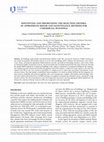
International Journal of Strategic Property Management, 2021
All buildings require Repair and Maintenance (R&M) in their life cycle period. However, if R&M ac... more All buildings require Repair and Maintenance (R&M) in their life cycle period. However, if R&M activities are not carried out properly, deterioration will occur, service life of buildings will be reduced, and maintenance costs will increase. Hence, selecting the appropriate R&M methods is pivotal, especially for developing countries, such as Iran, which are featured by highly constrained resources. The present study aims to identify and prioritize the main criteria for selecting the suitable R&M methods for Commercial Buildings (CBs), which is considered as a profound challenge for the Architecture, Engineering and Construction/Facility Management (AEC/FM) industry. A total of 20 senior experts in the AEC/FM industry and CBs in Iran were invited to participate in a Delphi survey to solicit their perceptions and opinions on the selection criteria. The total number of individual criteria identified is 16, which are further divided into five categories: human resources, flexibility and...

International Journal of Operational Research, 2021
What are the major factors able to increase the capacity of suppliers in outsourcing processes? T... more What are the major factors able to increase the capacity of suppliers in outsourcing processes? To answer this research question, a three-round Delphi survey was administered to an expert panel composed of 50 industrial experts of the Water and Wastewater Company (WWC) in Iran. The administered questionnaire – based on 50 items categorized into 4 groups: judicial-legal, contract, management, and financial – was developed based on prior literature and experts’ answers. Respondents have been asked to evaluate each item with regard to the capacity of suppliers in outsourcing processes on a 5-point Likert scale. Factor analysis, one-sample t-test and the Friedman test were used for data analysis. Results show that the factor categories able to increase the capacity of suppliers in outsourcing processes at WWC are the following, in order of importance: financial, judicial-legal, contracts, and management. The findings help to focus on the shortcomings and deficiencies of current outsourcing processes.
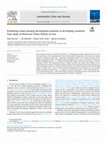
Sustainable Cities and Society, 2021
The restoration of Worn-out Urban Fabrics (WoUFs), i.e., the disfiguration of fabric components o... more The restoration of Worn-out Urban Fabrics (WoUFs), i.e., the disfiguration of fabric components of the city from their main shape, and the implementation of the urban housing development plan have always been pivotal activities for designing livable citiesespecially in developing countries. Prior research, however, did not identify an appropriate model of sustainable housing development for the recovery of WoUFs. To fill this gap, housing development patternsi.e., supportive housing, Mehr housing, rental, and social housingaimed at restoring the WoUF of the Hemmatabad district in Isfahan city (Iran) were studied. Expert opinions, on the criteria affecting the selection of housing development patterns, from 40 professionals in urban management and urban development models were collected and then analyzed by the Analytic Hierarchical Process and VIKOR method. It resulted that, in order to revive the WoUF of Hemmatabad, social housing is the more desirable pattern of housing development (Q i = 1) compared to supportive housing (Q i = 0.911), Mehr housing (Q i = 0.117) and rental housing (Q i = 0.004). Results help governments of developing countries in directing their effort in the decision of which housing development pattern for WoUFs to implement.
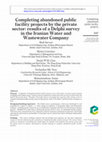
Journal of Facilities Management, 2020
Purpose Completion of abandoned public facility projects is one of the major concerns of governme... more Purpose Completion of abandoned public facility projects is one of the major concerns of governments struggling with budget issues. Various research studies have shown that this can only be solved with the help of the private sector. Therefore, this study aims to investigate the capacity of the private sector to complete abandoned public facility projects through the study of the Water and Wastewater Company in Iran. Design/methodology/approach The Delphi survey questionnaires, which were distributed to and responded by a panel of experts – i.e. three groups of employers of the Iranian Water and Wastewater Company, consulting agents and private sector stakeholders engaging with Water and Wastewater Company projects – identified 50 critical factors allowing the private sector to carry out abandoned facility projects. These have been categorized into four components: financial capacities, management competency, knowledge and expertise and resources and facilities. A descriptive survey...
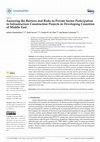
Sustainability, 2020
In developing countries, governments are often unable to implement urban infrastructure construct... more In developing countries, governments are often unable to implement urban infrastructure construction projects (UICPs) on their own, mainly due to budget and financial resource limitations. The participation of the private sector, through public–private partnerships (PPPs), has been considered as an alternative effective method for increasing the efficiency and productivity of urban infrastructure development. However, in many developing countries such as those situated in the Middle East, attracting private sector investments for UICPs uncovers profound challenges that have not ever been comprehensively accounted for and prioritized. To fill this knowledge gap, this study seeks to determine and prioritize the major barriers and risks faced by governments and urban managers in attracting private sector investments through the PPP schemes launched by developing countries in the Middle East. Based on a Delphi study conducted in Iran as an example, the opinions of 60 UICPs experts in bo...
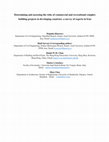
Journal of Facilities Management, 2020
Purpose As construction of commercial and recreational complex building projects (CRCBPs) is one ... more Purpose As construction of commercial and recreational complex building projects (CRCBPs) is one of the most important issues in many developing countries and requires a very high cost of implementation, it is important to identify and prioritize the risks of such projects. Therefore, the purpose of this study is to identify and rank the risks of CRCBPs by studying the case of the “Hamedanian Memorial,” a CRCBP in Iran. Design/methodology/approach To pursue this aim, a descriptive-survey method was used. The statistical population of the study consists of 30 experienced experts (consultants, contractors and employers) of the “Hamedanian Memorial” project selected according to the Cochran formula and minimum population census. A questionnaire was used as the data collection tool, administered in all stages of risk identification and evaluation, and was devised by using library and field methods based on the literature and research background, as well as interviewing experts in the ri...
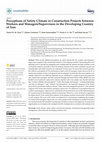
Sustainability, 2021
What are the different perceptions on safety climate (SC) by workers and managers/supervisors eng... more What are the different perceptions on safety climate (SC) by workers and managers/supervisors engaged in the construction industry of developing countries? Reconciling these two differing views is pivotal for mitigating and avoiding both the injured and fatal accidents in the construction industry, especially in those developing countries where safety conditions are poor and unpredictable, and safety measures are inadequate in most cases. To answer this research question, the collective perceptions of 118 construction workers and 123 managers/supervisors on the SC in construction projects in Iran were gleaned and investigated. In particular, these perceptions were initially collected by two different empirical surveys validated by a sample of university professors and construction managers and then analyzed through the Kaiser-Meyer-Olkin (KMO) test and Bartlett’s test of sphericity under factor analysis, together with a one-sample t-test. Results indicated that “workers’ attitudes a...








Uploads
Videos by Matteo Cristofaro
Teaching Documents by Matteo Cristofaro
The class was held in December 2014 as a part of the larger course "General Management" at the University of Rome Tor Vergata.
Main contents are: business modeling, business model innovation, blue ocean strategy, BMI as a set od key decision.
Questa presentazione riguarda il processo decisionale consigliato per la scelta dei paesi in cui concentrare gli sforzi dell'azienda, al fine di raggiungere l'internazionalizzazione del proprio business; in particolare, questa lezione è focalizzata sul secondo fattore del processo decisionale: l'ccessibilità dei mercati esteri.
Questa presentazione riguarda il processo decisionale consigliato che si propone di fare per la scelta dei paesi in cui concentrare gli sforzi dell'azienda per raggiungere l'internazionalizzazione; in particolare, questa lezione è focalizzata sul primo fattore del processo decisionale: attrattività dei mercati esteri.
Papers by Matteo Cristofaro
Based on 40 semi-structured interviews with Italian SMEs and LCs engaged in various industries, 20 open OI projects involving SMEs and LCs are investigated using a reflexive thematic analysis, a methodology involving both deductive and inductive approaches.
Fifteen CSFs grouped into seven categories emerge from the analysis of joint OI projects between SMEs and LCs. Among them, shared leadership, dynamic decision-making and priority setting emerge as essential elements at the basis of the proposed SMEs–LCs cooperation in joint OI projects that were not sufficiently addressed by prior studies.
To the best of the authors’ knowledge, this study is the first to provide an evidence-based framework for managing joint OI projects between SMEs and LCs. Relatedly, this study links the practices and most recurring CSFs that facilitate such cooperation.
The class was held in December 2014 as a part of the larger course "General Management" at the University of Rome Tor Vergata.
Main contents are: business modeling, business model innovation, blue ocean strategy, BMI as a set od key decision.
Questa presentazione riguarda il processo decisionale consigliato per la scelta dei paesi in cui concentrare gli sforzi dell'azienda, al fine di raggiungere l'internazionalizzazione del proprio business; in particolare, questa lezione è focalizzata sul secondo fattore del processo decisionale: l'ccessibilità dei mercati esteri.
Questa presentazione riguarda il processo decisionale consigliato che si propone di fare per la scelta dei paesi in cui concentrare gli sforzi dell'azienda per raggiungere l'internazionalizzazione; in particolare, questa lezione è focalizzata sul primo fattore del processo decisionale: attrattività dei mercati esteri.
Based on 40 semi-structured interviews with Italian SMEs and LCs engaged in various industries, 20 open OI projects involving SMEs and LCs are investigated using a reflexive thematic analysis, a methodology involving both deductive and inductive approaches.
Fifteen CSFs grouped into seven categories emerge from the analysis of joint OI projects between SMEs and LCs. Among them, shared leadership, dynamic decision-making and priority setting emerge as essential elements at the basis of the proposed SMEs–LCs cooperation in joint OI projects that were not sufficiently addressed by prior studies.
To the best of the authors’ knowledge, this study is the first to provide an evidence-based framework for managing joint OI projects between SMEs and LCs. Relatedly, this study links the practices and most recurring CSFs that facilitate such cooperation.